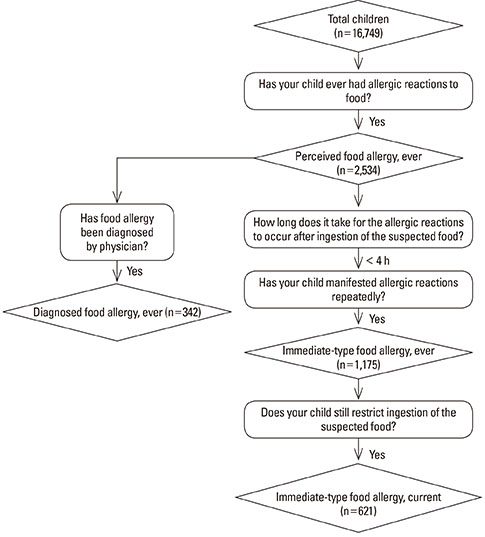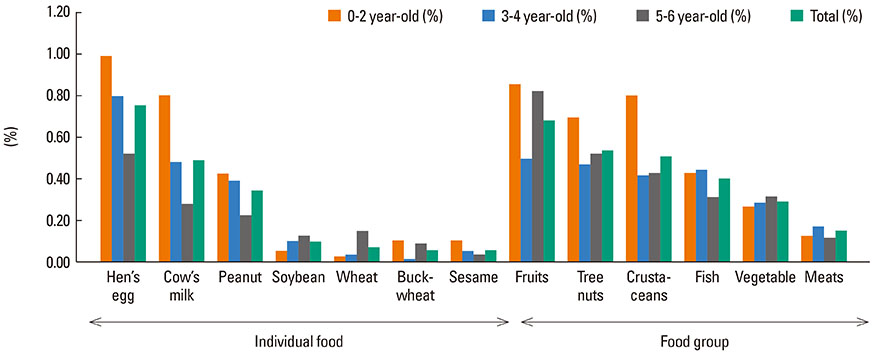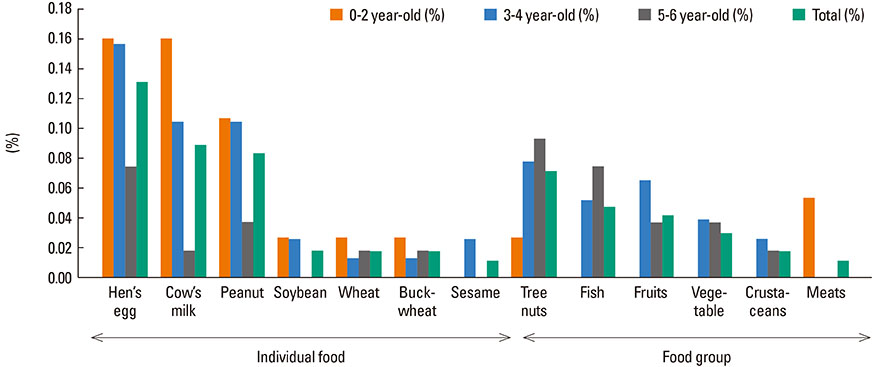Prevalence of Immediate-Type Food Allergy in Early Childhood in Seoul
- Affiliations
-
- 1Department of Pediatrics, Samsung Medical Center, Sungkyunkwan University School of Medicine, Seoul, Korea. jhlovechild@hotmail.com
- 2Environmental Health Center for Atopic Diseases, Samsung Medical Center, Seoul, Korea. snuhan@skku.edu
- KMID: 2260257
- DOI: http://doi.org/10.4168/aair.2014.6.2.131
Abstract
- PURPOSE
There are scanty epidemiologic data on the prevalence of food allergy (FA) among preschool children in Asia. We performed this study to determine the prevalence and causative foods of immediate-type FA in early childhood in Korea.
METHODS
A questionnaire-based, cross-sectional study was performed between September and October 2011. Children aged 0-6 years were recruited from 301 public child care centers in Seoul. Parents were asked to complete a questionnaire on FA. Children with FA were classified into "perceived FA, ever," "immediate-type FA, ever," and "immediate-type FA, current" according to the algorithm.
RESULTS
A total of 16,749 children were included in this study. The prevalence of "perceived FA, ever," "immediate-type FA, ever," and "immediate-type FA, current" was 15.1%, 7.0%, and 3.7%, respectively. "Immediate-type FA, current" was reported by 182 (4.9%) out of 3,738 children aged < or =2 years, 262 (3.4%) of 7,648 children aged 3-4 years, and 177 (3.3%) of 5,363 children aged 5-6 years. Hen's egg (126/621) was the most frequent cause as the individual food item, followed by cow's milk (82/621) and peanut (58/621). Among the food groups, fruits (114/621), tree nuts (90/621) and crustaceans (85/621) were the most common offending foods. The three leading causes of food-induced anaphylaxis were hen's egg (22/47), cow's milk (15/47), and peanut (14/47).
CONCLUSIONS
The prevalence of immediate-type FA in early childhood is 3.7%, and is higher in younger children. The most common offending foods differed with age.
Keyword
MeSH Terms
Figure
Cited by 13 articles
-
Update on Early Nutrition and Food Allergy in Children
Sun Eun Lee, Hyeyoung Kim
Yonsei Med J. 2016;57(3):542-548. doi: 10.3349/ymj.2016.57.3.542.Food allergy in children: focus on IgE-mediated food allergy
Sooyoung Lee
J Korean Med Assoc. 2017;60(3):242-248. doi: 10.5124/jkma.2017.60.3.242.Reduction Rate of Specific IgE Level as a Predictor of Persistent Egg Allergy in Children
Jong Deok Kim, Soo Yeon Kim, Eun Ji Kwak, In Suk Sol, Min Jung Kim, Yoon Hee Kim, Kyung Won Kim, Myung Hyun Sohn
Allergy Asthma Immunol Res. 2019;11(4):498-507. doi: 10.4168/aair.2019.11.4.498.Update on egg allergy in children
Meeyong Shin
Allergy Asthma Respir Dis. 2015;3(1):15-21. doi: 10.4168/aard.2015.3.1.15.Usefulness of casein specific IgE and IgG antibodies to immediate type cow's milk allergy
Ja Hyun Lim, Kyung Uk Jeong, Jeong-Min Lee, Kyung Eun Lee, Sooyoung Lee
Allergy Asthma Respir Dis. 2015;3(2):139-144. doi: 10.4168/aard.2015.3.2.139.Development and properties of hypoallergenic infant formula
Woel-Kyu Ha, Jeongmin Lee, Kyu-Earn Kim
Allergy Asthma Respir Dis. 2017;5(2):63-72. doi: 10.4168/aard.2017.5.2.63.The past, present, and future of the research on food allergy in Korean children
Kangmo Ahn
Allergy Asthma Respir Dis. 2018;6(Suppl 1):S44-S51. doi: 10.4168/aard.2018.6.S1.S44.The past, present, and future of research on anaphylaxis in Korean children
Sooyoung Lee
Allergy Asthma Respir Dis. 2018;6(Suppl 1):S21-S30. doi: 10.4168/aard.2018.6.S1.S21.Safety of influenza vaccination in children with allergic diseases
Hyeon-Jong Yang
Clin Exp Vaccine Res. 2015;4(2):137-144. doi: 10.7774/cevr.2015.4.2.137.Time trends of the prevalence of allergic diseases in Korea: A systematic literature review
Sung-Yoon Kang, Woo-Jung Song, Sang-Heon Cho, Yoon-Seok Chang
Asia Pac Allergy. 2018;8(1):. doi: 10.5415/apallergy.2018.8.e8.Age-Based Causes and Clinical Characteristics of Immediate-Type Food Allergy in Korean Children
Kyunguk Jeong, Jihyun Kim, Kangmo Ahn, So-Yeon Lee, Taek Ki Min, Bok Yang Pyun, Yoon Hee Kim, Kyung Won Kim, Myung Hyun Sohn, Kyu-Earn Kim, Gwang Cheon Jang, Tae-Won Song, Jung Hee Kim, You Hoon Jeon, Yong Ju Lee, Yong Mean Park, Hye Yung Yum, Hyun Hee Kim, Woo Kyung Kim, Sooyoung Lee
Allergy Asthma Immunol Res. 2017;9(5):423-430. doi: 10.4168/aair.2017.9.5.423.Clinical characteristics and causative food types of immediate-type cow’ s milk and egg white allergy in children
Eunjoo Lee, Kyunguk Jeong, Ji Young Lee, Taek Ki Min, Minji Kim, Hea-Kyoung Yang, Hae Won Lee, Jihyun Kim, Kangmo Ahn, Bok Yang Pyun, Sooyoung Lee
Allergy Asthma Respir Dis. 2017;5(6):351-357. doi: 10.4168/aard.2017.5.6.351.Epidemiology of food allergy in Korean children
Taek Ki Min, Bok Yang Pyun, Hyun Hee Kim, Yong-Mean Park, Gwang Cheon Jang, Hye-Young Kim, Hye Yung Yum, Jihyun Kim, Kangmo Ahn, Sooyoung Lee, Kyung Won Kim, Yoon Hee Kim, Jeong-Min Lee, Woo Kyung Kim, Tae Won Song, Jeong Hee Kim, Yong Ju Lee, You Hoon Jeon, So-Yeon Lee
Allergy Asthma Respir Dis. 2018;6(1):4-13. doi: 10.4168/aard.2018.6.1.4.
Reference
-
1. Sicherer SH, Sampson HA. Food allergy. J Allergy Clin Immunol. 2010; 125:S116–S125.2. Rona RJ, Keil T, Summers C, Gislason D, Zuidmeer L, Sodergren E, Sigurdardottir ST, Lindner T, Goldhahn K, Dahlstrom J, McBride D, Madsen C. The prevalence of food allergy: a meta-analysis. J Allergy Clin Immunol. 2007; 120:638–646.3. Lao-araya M, Trakultivakorn M. Prevalence of food allergy among preschool children in northern Thailand. Pediatr Int. 2012; 54:238–243.4. Wu TC, Tsai TC, Huang CF, Chang FY, Lin CC, Huang IF, Chu CH, Lau BH, Wu L, Peng HJ, Tang RB. Prevalence of food allergy in Taiwan: a questionnaire-based survey. Intern Med J. 2012; 42:1310–1315.5. Ahn K, Kim J, Hahm MI, Lee SY, Kim WK, Chae Y, Park YM, Han MY, Lee KJ, Kim JK, Yang ES, Kwon HJ. Prevalence of immediate-type food allergy in Korean schoolchildren: a population-based study. Allergy Asthma Proc. 2012; 33:481–487.6. Kim J, Chang E, Han Y, Ahn K, Lee SI. The incidence and risk factors of immediate type food allergy during the first year of life in Korean infants: a birth cohort study. Pediatr Allergy Immunol. 2011; 22:715–719.7. Sicherer SH, Sampson HA. 9. Food allergy. J Allergy Clin Immunol. 2006; 117:S470–S475.8. Yun J, Katelaris CH. Food allergy in adolescents and adults. Intern Med J. 2009; 39:475–478.9. Sampson HA, Muñoz-Furlong A, Campbell RL, Adkinson NF Jr, Bock SA, Branum A, Brown SG, Camargo CA Jr, Cydulka R, Galli SJ, Gidudu J, Gruchalla RS, Harlor AD Jr, Hepner DL, Lewis LM, Lieberman PL, Metcalfe DD, O'Connor R, Muraro A, Rudman A, Schmitt C, Scherrer D, Simons FE, Thomas S, Wood JP, Decker WW. Second symposium on the definition and management of anaphylaxis: summary report--second National Institute of Allergy and Infectious Disease/Food Allergy and Anaphylaxis Network symposium. Ann Emerg Med. 2006; 47:373–380.10. Leung TF, Yung E, Wong YS, Lam CW, Wong GW. Parent-reported adverse food reactions in Hong Kong Chinese pre-schoolers: epidemiology, clinical spectrum and risk factors. Pediatr Allergy Immunol. 2009; 20:339–346.11. Iikura Y, Imai Y, Imai T, Akasawa A, Fujita K, Hoshiyama K, Nakura H, Kohno Y, Koike K, Okudaira H, Iwasaki E. Frequency of immediate-type food allergy in children in Japan. Int Arch Allergy Immunol. 1999; 118:251–252.12. Marrugo J, Hernández L, Villalba V. Prevalence of self-reported food allergy in Cartagena (Colombia) population. Allergol Immunopathol (Madr). 2008; 36:320–324.13. Liu AH, Jaramillo R, Sicherer SH, Wood RA, Bock SA, Burks AW, Massing M, Cohn RD, Zeldin DC. National prevalence and risk factors for food allergy and relationship to asthma: results from the National Health and Nutrition Examination Survey 2005-2006. J Allergy Clin Immunol. 2010; 126:798–806.e13.14. Eller E, Kjaer HF, Høst A, Andersen KE, Bindslev-Jensen C. Food allergy and food sensitization in early childhood: results from the DARC cohort. Allergy. 2009; 64:1023–1029.15. Jung YH, Ko H, Kim HY, Seo JH, Kwon JW, Kim BJ, Kim HB, Lee SY, Jang GC, Song DJ, Kim WK, Shim JY, Hong SJ. Prevalence and risk factors of food allergy in preschool children in Seoul. Korean J Asthma Allergy Clin Immunol. 2011; 31:177–183.16. Han Y, Kim J, Ahn K. Food allergy. Korean J Pediatr. 2012; 55:153–158.17. Al-Hammadi S, Al-Maskari F, Bernsen R. Prevalence of food allergy among children in Al-Ain city, United Arab Emirates. Int Arch Allergy Immunol. 2010; 151:336–342.18. Dalal I, Binson I, Reifen R, Amitai Z, Shohat T, Rahmani S, Levine A, Ballin A, Somekh E. Food allergy is a matter of geography after all: sesame as a major cause of severe IgE-mediated food allergic reactions among infants and young children in Israel. Allergy. 2002; 57:362–365.19. Kagan RS, Joseph L, Dufresne C, Gray-Donald K, Turnbull E, Pierre YS, Clarke AE. Prevalence of peanut allergy in primary-school children in Montreal, Canada. J Allergy Clin Immunol. 2003; 112:1223–1228.20. Grundy J, Matthews S, Bateman B, Dean T, Arshad SH. Rising prevalence of allergy to peanut in children: data from 2 sequential cohorts. J Allergy Clin Immunol. 2002; 110:784–789.21. Mullins RJ, Dear KB, Tang ML. Characteristics of childhood peanut allergy in the Australian Capital Territory, 1995 to 2007. J Allergy Clin Immunol. 2009; 123:689–693.22. Shek LP, Cabrera-Morales EA, Soh SE, Gerez I, Ng PZ, Yi FC, Ma S, Lee BW. A population-based questionnaire survey on the prevalence of peanut, tree nut, and shellfish allergy in 2 Asian populations. J Allergy Clin Immunol. 2010; 126:324–331. 331.e1–331.e7.23. Gupta RS, Springston EE, Warrier MR, Smith B, Kumar R, Pongracic J, Holl JL. The prevalence, severity, and distribution of childhood food allergy in the United States. Pediatrics. 2011; 128:e9–e17.24. Steckelbroeck S, Ballmer-Weber BK, Vieths S. Potential, pitfalls, and prospects of food allergy diagnostics with recombinant allergens or synthetic sequential epitopes. J Allergy Clin Immunol. 2008; 121:1323–1330.25. Baatenburg de Jong A, Dikkeschei LD, Brand PL. High prevalence of sensitization to aeroallergens in children 4 yrs of age or younger with symptoms of allergic disease. Pediatr Allergy Immunol. 2009; 20:735–740.26. Zeiger RS, Heller S. The development and prediction of atopy in high-risk children: follow-up at age seven years in a prospective randomized study of combined maternal and infant food allergen avoidance. J Allergy Clin Immunol. 1995; 95:1179–1190.27. Dalal I, Binson I, Levine A, Somekh E, Ballin A, Reifen R. The pattern of sesame sensitivity among infants and children. Pediatr Allergy Immunol. 2003; 14:312–316.
- Full Text Links
- Actions
-
Cited
- CITED
-
- Close
- Share
- Similar articles
-
- The management of food allergy in Indonesia
- The past, present, and future of the research on food allergy in Korean children
- Prevalence of food allergy and perceptions on food allergen labeling in school foodservice among Korean students
- Food Allergy: Diagnosis and Management
- Update on Early Nutrition and Food Allergy in Children




